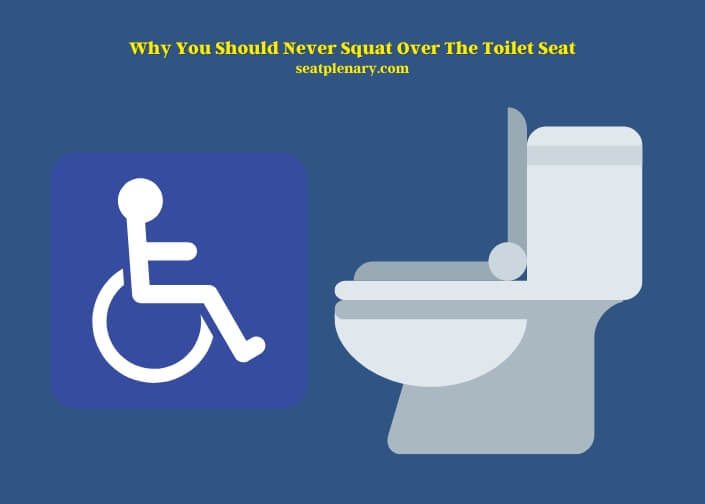Squatting over a toilet seat is a practice often adopted for hygiene reasons, but it can have unintended consequences. Many believe it’s a cleaner alternative to sitting, yet this method can lead to health and safety issues.
Squatting over a toilet seat, especially in public restrooms, is seen as a way to avoid direct contact with germs. However, this approach can be counterproductive. The human body is designed to sit, not squat, during elimination. This position ensures that the muscles around the bladder and bowel are relaxed, allowing for a complete and healthy release. When you squat, these muscles remain tense, potentially leading to incomplete bladder or bowel emptying. Over time, this can cause constipation or urinary tract issues.

Moreover, balancing in a squat position on a western-style toilet is risky. It increases the chance of slipping or causing injury, particularly in restrooms where floors may be wet or slippery. Additionally, the pressure exerted on the toilet seat can lead to its damage, creating inconvenience and potential hazards for others.
Public restrooms are often equipped with seat covers or cleaning materials, providing safer options for those concerned about hygiene. Regular cleaning and maintenance of these facilities also reduce the risk of germ transmission.
For a deeper insight into the risks of squatting over the toilet seat and safer alternatives, we invite you to read the detailed article below. This information can guide you in making healthier and safer choices in public restrooms.
The Risks of Squatting Over Toilet Seats
The Myth of Hygiene in Squatting
Let’s talk about a common belief: squatting over a toilet seat is cleaner than sitting. It seems logical, right? You avoid direct contact with the seat, dodging those pesky germs. But here’s the twist: this well-intentioned practice might not be as hygienic as you think. When you squat, you’re not just avoiding germs; you’re also potentially spreading them. Think about it – maintaining balance while squatting isn’t easy, and it often leads to touching surfaces you were trying to avoid in the first place.
Physical Health Implications
Impact on Bowel and Bladder Function
Now, let’s dive into how squatting affects your body. Our bodies are designed to sit, not hover. When you sit, your muscles relax, making it easier for your bladder and bowel to do their job. Squatting, on the other hand, keeps these muscles tense. This tension can lead to incomplete bladder or bowel emptying. Over time, this could cause some serious health issues, like constipation or urinary tract infections.
Effects of Squatting vs. Sitting on Muscle Activity
| Muscle Activity | Squatting | Sitting |
| Pelvic Floor | High | Low |
| Bladder Control | Reduced | Optimal |
| Bowel Movement | Incomplete | Complete |
Long-Term Health Risks
Continuing with the health theme, let’s consider the long-term effects. Habitual squatting can lead to chronic bowel and bladder issues. It’s not just about the immediate discomfort; it’s about what happens if you make squatting a regular practice. These issues can sneak up on you and, before you know it, become a significant part of your life.
Safety Concerns and Accident Risks

Balance and Injury Risks in Public Restrooms
Safety is another big concern. Squatting on a western-style toilet isn’t just awkward; it’s a balancing act that can go wrong quickly. Slippery floors, unstable toilet seats – these are real hazards. Falls in the bathroom are no joke, and the risk is significantly higher when you’re trying to hover above a toilet seat.
Statistics of Restroom-Related Injuries
| Injury Type | Squatting | Sitting |
| Falls | High | Low |
| Muscle Strains | Common | Rare |
| Seat Damage | Likely | Unlikely |
Impact on Public Facilities
Damage to Plumbing and Toilet Seats
When you squat, you’re not just risking your own safety; you’re also potentially damaging public property. Toilet seats aren’t designed for the pressure and weight distribution that comes with squatting. This can lead to cracked seats and even plumbing issues, which means more maintenance and repair costs for the facility.
Psychological Effects and Social Considerations
Anxiety Over Public Restroom Use
There’s also a psychological angle to consider. The fear of germs in public restrooms can lead to anxiety and stress. While it’s essential to be cautious, excessive worry can impact your mental well-being. Plus, there’s the social aspect – different cultures have different restroom etiquettes, and being mindful of these can help reduce stress and promote understanding.
Hygienic and Safe Alternatives to Squatting
Use of Seat Covers and Sanitizers
So, what can you do instead of squatting? Simple: use seat covers or sanitizers. These are effective ways to protect yourself from germs without the risks associated with squatting. Most public restrooms provide these options, making it easy to stay hygienic and safe.
Effectiveness of Various Hygiene Practices
| Hygiene Practice | Germ Reduction | Safety |
| Seat Covers | High | High |
| Sanitizers | Moderate | High |
| Squatting | Low | Low |
Frequently Asked Questions (FAQs)
Can Squatting Over The Toilet Seat Affect Pregnancy?
Squatting over the toilet seat during pregnancy is not recommended. This position can put additional strain on the pelvic floor muscles, which are already under pressure due to the growing uterus. It can lead to pelvic floor dysfunction, a common issue during and after pregnancy. This dysfunction can manifest as incontinence or pelvic organ prolapse. Pregnant women are advised to sit down gently on the toilet seat to avoid unnecessary pressure on the pelvic region, ensuring both their safety and comfort.
Is Using a Cup Under the Toilet Seat a Hygienic Alternative to Squatting Over the Toilet?
Some believe that preventing toilet seat stains with a cup is a hygienic alternative to squatting over the toilet. However, this method may lead to unsanitary conditions if the cup is not properly cleaned after each use. It’s best to use disposable toilet seat covers for a more hygienic option.
Is There A Risk Of Infection From Sitting On Public Toilet Seats?
The risk of contracting infections from sitting on public toilet seats is actually quite low. Most pathogens that might be present on a toilet seat, like common bacteria or viruses, don’t survive long on such surfaces. Moreover, skin acts as an effective barrier against these germs. The likelihood of a germ entering your body through your skin is extremely low unless you have open wounds. Practicing basic hygiene, like washing your hands after using the restroom, is usually sufficient to prevent these infections.
Do People Have Strong Preferences for Keeping Toilet Seats Up or Down?
When it comes to up or down preference for toilet seats, people definitely have strong feelings. Some prefer the seat down for sanitary reasons, while others prefer it up for convenience. It’s a debate that continues to divide households and spark lively discussions.
Is an Open Toilet Seat More Sanitary Than Squatting Over the Seat?
Squatting over the seat to avoid open toilet seat risks may not be as sanitary as you think. Research shows that when done correctly, sitting on an open toilet seat can actually be more hygienic. In fact, squatting can increase the risk of spreading germs and bacteria.
Can Squatting Over the Toilet Seat Cause It to Become Sticky?
Squatting over the toilet seat can lead to stickiness due to the incorrect use of toilet paper. To avoid this issue, there are several solutions for stickiness that can be implemented, such as using a toilet seat cover or thoroughly cleaning the toilet seat after use.
Is Squatting Over a Toilet Seat Hygienic?
Many people wonder why paper seat covers are necessary when using public restrooms. Squatting over a toilet seat may seem hygienic, but it can actually increase the spread of bacteria and germs. Using a paper seat cover is an effective way to provide a protective barrier and maintain better hygiene in public restrooms.
Does Squatting Over The Toilet Affect Men Differently Than Women?
Squatting over the toilet can affect men and women differently, primarily due to differences in urinary tract anatomy. For men, the squatting position can lead to incomplete emptying of the bladder, increasing the risk of urinary tract infections and bladder issues. Additionally, for men with prostate conditions, this position can exacerbate symptoms. Both men and women, however, face similar risks regarding muscle strain and balance-related injuries.
Can Squatting Over The Toilet Lead To Hemorrhoids?
Squatting over the toilet seat can contribute to the development of hemorrhoids. This position increases strain and pressure in the lower rectum, which can aggravate existing hemorrhoids or lead to the formation of new ones. Sitting, on the other hand, allows for a more natural and less strained bowel movement, reducing the risk of developing hemorrhoids.
How Does Squatting Impact People With Mobility Issues?
For individuals with mobility issues, squatting over a toilet seat can be particularly risky. It requires a significant amount of balance, leg strength, and coordination, which can be challenging for those with limited mobility. This increases the risk of falls and injuries. It’s essential for individuals with mobility concerns to use assistive devices or adapted toilets to ensure their safety in the restroom.
Does Squatting Over The Toilet Seat Cause Muscle Imbalance?
Squatting over the toilet seat can lead to muscle imbalance and strain. This position puts undue stress on certain muscle groups in the legs and pelvic area while underutilizing others. Over time, this can lead to muscle weakness, imbalance, and even chronic pain issues. It’s important to maintain a natural posture that allows for even muscle engagement, which is achieved by sitting down on the toilet seat.
Can Squatting Over The Toilet Seat Affect Digestive Health?
Squatting over the toilet seat can negatively impact digestive health. This unnatural position can hinder the natural process of elimination, leading to incomplete bowel movements. Over time, this can cause issues like constipation or exacerbate existing digestive conditions. A sitting position, in contrast, aligns the body in a way that supports the natural process of elimination, promoting better digestive health.
Summary
To wrap it up, while squatting over a toilet seat might seem like a hygienic practice, it’s not without its risks. From health implications to safety hazards and the impact on public facilities, the downsides are significant. Instead, opt for safer and more effective hygiene practices like using seat covers or sanitizers. Remember, staying informed and making smart choices is key to your health and well-being.
